

High expectations / Principles. This section draws together research, digital resources, and examples to support leaders and teachers as they consider the high expectations principle.
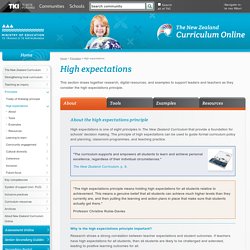
High expectations is one of eight principles in The New Zealand Curriculum that provide a foundation for schools' decision making. The principle of high expectations can be used to guide formal curriculum policy and planning, classroom programmes, and teaching practice. "The curriculum supports and empowers all students to learn and achieve personal excellence, regardless of their individual circumstances. " The New Zealand Curriculum, p. 9. "The high expectations principle means holding high expectations for all students relative to achievement. Research that changed my teaching. In the first of a series in which educators explain how research has transformed their practice, English and media teacher Hélène Galdin-O’Shea tells us about one paper that changed everything for her classroom.

Research paper: ‘Why minimal guidance during instruction does not work: an analysis of the failure of constructivist, discovery, problem-based, experiential, and inquiry-based teaching’Authors: Kirschner, Sweller and Clark, 2006. The end of my first decade as a teacher was nearly the end of my career as a teacher. I had become so frustrated with the way in which ‘outstanding’ teaching was defined and enforced that I was ready to give up.
When the focus of lesson planning becomes ‘What can I do in order not to explain this explicitly?’ As opposed to ‘How can I refine my explanations and polish the scaffolding work to maximise students’ understanding?’ After 13 years on the job, I went online, connected with many colleagues, and started reading. The one thing you need to read. Dr Efrat Furst, postdoctoral fellow and the learning incubator in the school of engineering and applied sciences at Harvard University.
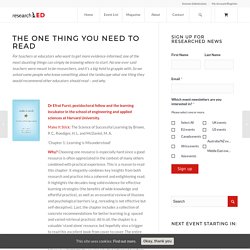
Make It Stick: The Science of Successful Learning by Brown, P. C., Roediger, H. L. and McDaniel, M. A.
Teaching as a profession? Assessment. Guidetoplacinglearnersonworkexperience. Instrumental Background Music For Presentations (Free Download) by AShamaluevMusic. Discussion Groups. Reflection. What is IBL? - IBL at Sheffield. Edutopia. There are plenty of studies that isolate the effects of light, acoustics, or air quality on learning. But the research on flexible classrooms is frustratingly scarce.
There are good reasons for the apparent lack of interest. Variables like natural light and acoustics lend themselves to single-factor experiments that can be conducted in a laboratory setting. Give subjects a task to complete in a room with ample windows, for example, and then administer the same test in a room without them. But flexible classrooms are complex, living systems. Despite the challenges, an ambitious effort to study the design of lived-in classrooms, including looking at hard-to-define factors like flexibility, was completed in 2015 by the University of Salford, in the United Kingdom. “We were trying to take a holistic perspective,” explained Peter Barrett, the lead researcher and now an honorary research fellow at the University of Oxford. The Findings The big insight? Form, Function, and Flexibility. Full Book A New Model Of Problem Based Learning Terry Barrett book.
A Really Simple Learning Design Framework. Developing e-learning courses that aren’t simply page turners isn’t straightforward (guess that’s why us learning designers are still able to make a meagre living).

It takes a lot of experience both of learning design and learning technologies combined to create engaging online learning experiences. However, there are some simple rules and methods you can follow to help ensure that your e-learning is more than just a boring old page turner. In this article I will describe a really simple approach that I first came across in ‘E-Learning by Design‘ by William Horton and which I use as a core part of my ‘Instructional Design for e-Learning‘ course. It’s called the ‘Absorb/Do/Connect’ approach. Micro-research: An Approach to Teaching and Learning.
At its simplest, Micro-research (also known as Inquiry-based Learning) involves getting students to undertake a relatively small research project and report back to their peers.

The purpose of the approach is to encourage students to develop a deeper understanding of the material they have been researching while also developing skills that will be useful for other parts of the study and their eventual careers, such as critical thinking and evaluation, communication and presentation skills and information literacy skills. The approach challenges students to move towards becoming independent and autonomous learners by requiring them to find their own answers, rather than relying on their tutors supplying the necessary information. How it Works. Home - Organisational Development and Professional Learning. What is EdTech? Education technology has become one of the most important topics of discussion among parents and educators.
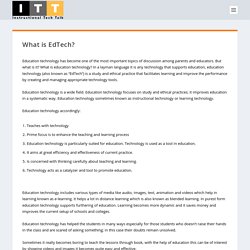
But what is it? What is education technology? In a layman language it is any technology that supports education, education technology (also known as “EdTech”) is a study and ethical practice that facilitates learning and improve the performance by creating and managing appropriate technology tools. Education technology is a wide field. Madeline Hunter Mastery Teaching. Broad instructional strategies that stimulate complex thinking. Because the forms of thinking just described—critical thinking, creativity and problem solving—are broad and important educationally, it is not surprising that educators have identified strategies to encourage their development.
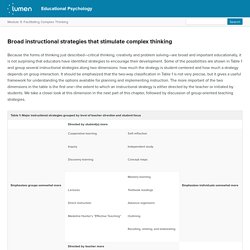
Some of the possibilities are shown in Table 1 and group several instructional strategies along two dimensions: how much the strategy is student-centered and how much a strategy depends on group interaction. It should be emphasized that the two-way classification in Table 1 is not very precise, but it gives a useful framework for understanding the options available for planning and implementing instruction. The more important of the two dimensions in the table is the first one—the extent to which an instructional strategy is either directed by the teacher or initiated by students. Elements of Lesson Design. Lesson Development | Lesson Planning Dr.

Madeline Hunter's research indicates that effective teachers usually include the following elements in their lessons. 1) Anticipatory Set - A short activity, dispatch or prompt that focuses the students' attention and ties previous lessons to today's lesson. 2) Purpose - An explanation of the importance of this lesson and a statement concerning what students will be able to do when they have completed it. 3) Input - The vocabulary, skills, and concepts to be learned. 4) Modeling - The teacher demonstrates what is to be learned 5) Guided Practice - The teacher leads the students through the steps necessary to perform the skill using multiple modalities. 6) Checking For Understanding - The teacher uses a variety of questioning strategies to determine if the students are understanding. 7) Independent Practice - The teacher releases students to practice on their own.
Adult Literacy, Numeracy and Cultural Capability » Ako Aotearoa. Kia ora and welcome to our new home for literacy, numeracy (LLN) and cultural capability resources to support people working with adult learners.

Inclusive classrooms. Learning. Learning theory. Learning Design. Teacher actions that promote student learning / Effective pedagogy for all students / Implementing an inclusive curriculum / Inclusive practices. Effective teachers teach all their students effectively.
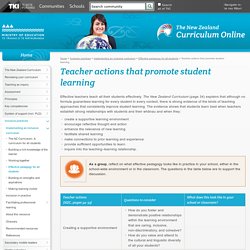
Pedagogies & Strategies. CL1 - FAQs: "Collaborative versus cooperative learning?" "What's the difference between collaborative and cooperative learning? " The terms collaborative learning and cooperative learning sometimes are used interchangeably. This is reasonable, as both favor small-group active student participation over passive, lecture-based teaching and each require a specific task to be completed. Each strategy inherently supports a discovery based approach to learning. The two methods assign various group roles though collaborative learning can have fewer roles assigned. In both situations, student members are required to possess group skills though cooperative learning may include this as a instructional goal. However, practioners point out that these two terms are different. Cooper, J., and Robinson, P. (1998). MacGregor, J. (1990). Rockwood, H. Rockwood, H. Teaching Skills.
11.3 Step One: Decide how you want to teach. Chapter 4: Methods of teaching with an online focus. 3.1 Five perspectives on teaching – Teaching in a Digital Age. Creating a teaching and learning space - Federation University Australia. Supporting future-oriented learning and teaching: A New Zealand perspective. Executive Summary. Using Technology to Enhance Student Space and Student Engagement. A student-led project created a technology-enabled gathering place that increases student engagement with information, programs, and services.
Like many other institutions of higher education, the Community College of Allegheny County (CCAC) strives to keep pace with the technological preferences of its millennial learners. Teaching Principles - Eberly Center. Teaching is a complex, multifaceted activity, often requiring us as instructors to juggle multiple tasks and goals simultaneously and flexibly. The following small but powerful set of principles can make teaching both more effective and more efficient, by helping us create the conditions that support student learning and minimize the need for revising materials, content, and policies. While implementing these principles requires a commitment in time and effort, it often saves time and energy later on. Effective teaching involves acquiring relevant knowledge about students and using that knowledge to inform our course design and classroom teaching.
When we teach, we do not just teach the content, we teach students the content. Chickering and Gamson 7 Rules for Undergraduate Education » Center for Instructional Technology & Training » University of Florida. Overview. Overview of Learning Theories. Learning Theories and Models summaries - Educational Psychology. 2.7 Is the nature of knowledge changing? – Teaching in a Digital Age. 2.7.1 Knowledge and technology Before moving on to the more pragmatic elements of teaching in a digital age, it is necessary to address the question of whether the development of digital technologies has actually changed the nature of knowledge, because if that is the case, then this will influence strongly what needs to be taught as well as how it will be taught.
Connectivists such as Siemens and Downes argue that the Internet has changed the nature of knowledge. They argue that ‘important’ or ‘valid’ knowledge now is different from prior forms of knowledge, particularly academic knowledge. Downes (2007) has argued that new technologies allow for the de-institutionalisation of learning. Chris Anderson, the editor of Wired Magazine and now CEO of Ted Talks, has argued (2008) that massive meta-data correlations can replace ‘traditional’ scientific approaches to creating new knowledge: One way knowledge is certainly changing is in the way it is represented. 2.7.2 Knowledge as a commodity 1. 1.2 The skills needed in a digital age – Teaching in a Digital Age. 1.1 Structural changes in the economy: the growth of a knowledge society – Teaching in a Digital Age. 2.1 Art, theory, research, and best practices in teaching – Teaching in a Digital Age.